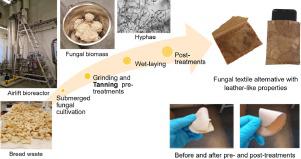Resources, Conservation and Recycling ( IF 13.2 ) Pub Date : 2021-11-20 , DOI: 10.1016/j.resconrec.2021.106041 E.R. Kanishka B. Wijayarathna , Ghasem Mohammadkhani , Amir M. Soufiani , Karin H. Adolfsson , Jorge A. Ferreira , Minna Hakkarainen , Linn Berglund , Ivo Heinmaa , Andrew Root , Akram Zamani

|
Food waste and fashion pollution are two of the most prominent global environmental issues. To alleviate the problems associated with food waste, while simultaneously contributing to sustainable fashion, the feasibility of making an alternative textile material with leather-like properties from fungal biomass cultivated on bread waste was investigated. The filamentous fungus, Rhizopus delemar, was successfully grown on waste bread in a submerged cultivation process, and fungal biomass was treated with vegetable tannin of chestnut wood. NMR and FTIR confirmed interactions between tannin and fungal biomass, while OM, SEM and AFM visualised the changes in the hyphae upon the tannin treatment. Thermal stability was assessed using TGA analysis. The wet-laid technique commonly utilised for paper-making was used to prepare sheets of hyphae. Some of the sheets were treated with glycerol and/or a biobased binder as post-treatment. Overall, three of the produced materials exhibited leather-like properties comparable to that of natural leather. Sheets from untreated biomass with only glycerol post-treatment showed a tensile strength of 7.7 MPa and an elongation at break of 5%. Whereas sheets from untreated biomass and tannin treated biomass with both glycerol and binder treatments led to tensile strengths of 7.1 MPa and 6.9 MPa, and the elongation at break of 12% and 17%, respectively. The enhancement of hydrophobicity after the binder treatment, helped to preserve the absorbed glycerol within the sheet and thereby the flexibility was retained when in contact with moisture. These findings demonstrate that bread waste-derived fungal sheets have great potential as environmentally friendly materials with leather-like properties.
中文翻译:

来自面包废料的真菌纺织品替代品具有类似皮革的特性
食物浪费和时尚污染是两个最突出的全球环境问题。为了缓解与食物浪费相关的问题,同时为可持续时尚做出贡献,研究了用面包废料上培养的真菌生物质制造具有皮革样特性的替代纺织材料的可行性。丝状真菌, Rhizopus delemar, 成功地在废面包上通过沉水栽培过程生长,真菌生物质用板栗木的植物单宁处理。NMR 和 FTIR 证实了单宁和真菌生物质之间的相互作用,而 OM、SEM 和 AFM 则显示了单宁处理后菌丝的变化。使用 TGA 分析评估热稳定性。通常用于造纸的湿法成网技术用于制备菌丝片。一些片材用甘油和/或生物基粘合剂处理作为后处理。总体而言,生产的三种材料表现出与天然皮革相当的皮革特性。来自仅用甘油后处理的未处理生物质的片材显示出 7.7 MPa 的拉伸强度和 5% 的断裂伸长率。而来自未经处理的生物质和单宁处理的生物质的片材用甘油和粘合剂处理导致拉伸强度分别为 7.1 MPa 和 6.9 MPa,断裂伸长率分别为 12% 和 17%。粘合剂处理后疏水性的增强有助于将吸收的甘油保持在片材内,从而在与水分接触时保持柔韧性。这些发现表明,面包废料衍生的真菌片作为具有皮革特性的环保材料具有巨大的潜力。有助于将吸收的甘油保存在片材内,从而在与水分接触时保持柔韧性。这些发现表明,面包废料衍生的真菌片作为具有皮革特性的环保材料具有巨大的潜力。有助于将吸收的甘油保存在片材内,从而在与水分接触时保持柔韧性。这些发现表明,面包废料衍生的真菌片作为具有皮革特性的环保材料具有巨大的潜力。



























 京公网安备 11010802027423号
京公网安备 11010802027423号